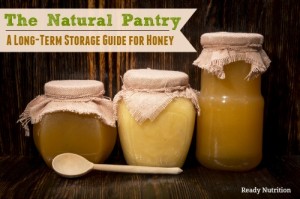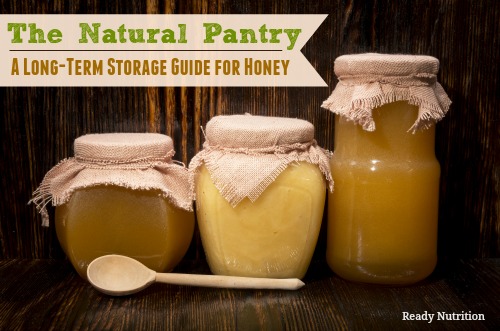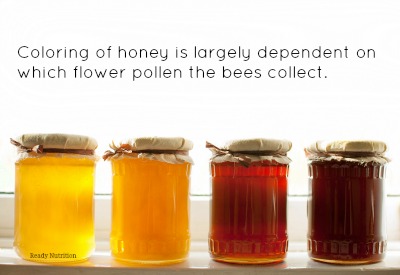Raw, unfiltered, unpasteurized honey has been a pantry staple [2] for centuries. In the far stretches of human history, honey was stored for food, making wine and used for medicinal purposes [3]. They stored raw, unfiltered honey in porous, sealed jars and stacked them in cold caves. In fact, recently, scientists examined five-millennia-plus-old jars of honey unearthed in Georgia and declared that the artifacts contain the world’s oldest honey [4]. This only proves that honey can stand the test of time [5] – but there is no guarantee it will. If improperly stored, honey can crystallize or ferment. This article will explain the what, when and why’s of how to perfectly store your honey for long-term use, as well as explain what mistakes to avoid.
There are more than 300 different types of honey in the United States, each with a unique flavor and color depending on the blossoms visited by the honey bees. In fact, the coloring of honey is largely dependent on which flower pollen it collects. For instance, honey is a darker color when nectar is collected from blossoms of avocado and buckwheat, while nectar collected from blueberries, alfalfa, clover and sage are lighter in color. In general, the lighter the color of honey, the milder the flavor.
Where to Find Bulk Honey
Buying honey at the store can be expensive, especially in bulk quantities. For years, my husband and I were purchasing five pound containers of honey for over $20, when we could have purchased it for much cheaper from local distributors. I was lucky to find a local honey supplier in my area that sells us 20 pounds of honey at a time for a better deal. This is enough for a year supply of honey for my family. We usually end up purchasing one to use for the year and another for long-term storage. As well, farmers markets are great for finding local produce, meat and honey. I have also found locals selling honey through Craigslist. If you plan on purchasing honey from a local supplier, make sure they can answer these questions:
- What are the kinds of flowers the bees have been foraging on?
- Is it organic honey?
- Do they mix the honey with any additives?
- Has the honey been filtered to remove pollen?
Read more about the importance of buying raw, unfiltered honey [7] and where to find it.
Properly Storing Honey
As dependable as honey is in a crisis, it can be finicky if not stored properly. Where and how you store honey makes a huge difference. If honey is stored in the wrong place, it’s viscosity, color, texture, aroma and flavor can change.
Like most of your pantry items, honey should be stored in a cool, dry area avoiding sunlight. The best storage temperature for honey is between 70-80°F, and is best if kept at a constant temperature with minimal fluctuations. Therefore, try to avoid storing honey near “hot or cold spots” in the home or by air conditioning or heating areas. If the temperature drops below 65°F, honey will begin to crystallize.
Interestingly, did you know that honey can be frozen? Liquid high-glucose honey that is frozen, will never crystallize and never lose vital nutrients. Although most preppers prefer not to concentrate their preparedness stores in the freezer, it can be used.
The main two points to keep in mind:
- Honey should stay at a constant temperature with minimal fluctuations. Erratic temperature fluctuations can quickly cause the honey to stay in a perpetual state of crystallizing or liquefying. According to a Master Beekeeping Program [8] hosted at Cornell University, if honey is stored at 77°F for 40 days, it will incur as much damage as honey heated to 145 °F for 60 minutes. The constant cool temperatures of root cellars (55°F) are perfect for storing creamed honey and will minimally affect the viscosity and texture.
- Moisture can also greatly affect honey. Too much moisture, and it begins to ferment. If you see clear liquid floating on top a more solid brown honey mass, then the honey has started the fermentation process. While fermentation does not necessarily pose any health risk (mead by the way is fermented honey), it could destroy the integrity of the honey. As well, because honey absorbs moisture, it should be kept it in a tightly lidded container.
Best Containers for Re-Packing Honey:
- Plastic food grade buckets [9] – I have my long-term honey stored in 2-gallon containers. I avoid storing honey in 5-gallon containers for long-term storage because of the possibility of crystallization and fermentation. I’d rather lose a jar of honey than a pail of honey. Make sure that your containers are BPA free and food grade.
- Glass canning jars [10] – My short-term pantry is stocked with honey filled quart-sized (wide mouth) canning jars. These also make great gifts!
- Plastic containers [11] – Plastic containers and jars that once held honey are great for short-term storage, as well. However, if honey ferments, the pressure could pop the top off and cause a big mess.
- Repurposed glass jars – Glass jars can also be reused for other purposes [12]. Make sure that the jars are thoroughly washed before reusing. If you do not have any jars to repurpose, these make excellent honey containers. [13]
Keep in mind that because crystallization can easily occur, many suggest that if you purchase large quantities of honey for long-term storage, you should distribute it into smaller, more usable quantities to minimize any issues that may occur. That way, if it does solidify or crystallize, you can scoop out honey in smaller containers easier than the larger 5-gallon pails.
A Word on Crystallization
As much as we try to prevent crystallization in honey, it is a natural process. The higher the glucose/fructose level in your honey the faster it happens; as well, temperature fluctuations can also increase crystallization.
If your honey crystallizes, it is still edible – just not in the way you were expecting. Many suggest adding the crystallized honey to a double boiler and heating it up. While you can do this, it will destroy any health benefits honey offers. Crystallized honey is delicious in tea, on yogurt, on a toasted bagel, and on oatmeal. It can also be used as a glaze for cooking meat or vegetables. Moreover, you can make granulated or creamed honey by mixing one part of crystallized honey with 9 parts of liquid honey. Store it at 55 degrees°F until it becomes firm.
To conclude, those who are making attempts at storing natural foods in their pantry can do no wrong by storing honey. It is one of the most versatile preps you can have on hand and a viable investment in long-term preparedness planning. Use the above listed storage tips to make the most of your investment so you can enjoy this liquid sweetener for years to come.
Additional Resources:
‘Honeytime, Anytime’ booklet [14]
USDA Honey Labeling [15]
National Honey Board [16]


